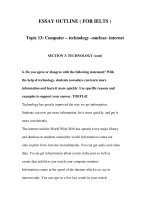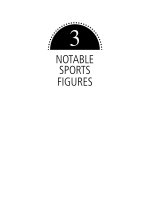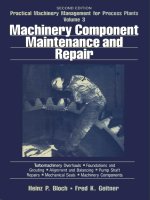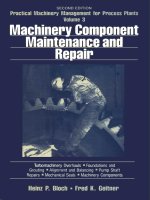Machinery Management for Process Plants Volume 3 doc
Bạn đang xem bản rút gọn của tài liệu. Xem và tải ngay bản đầy đủ của tài liệu tại đây (14.03 MB, 614 trang )
SECOND EDITION
Practical
Machinery
Management
for
Process
Plants
Volume
3
Turbomachinery Overhauls
.
Foundations and
Repairs
.
Mechanical Seals
.
Machinery Components
Grouting
.
Alignment and Balancing Pump Shaft
Heinz
P.
Bloch
.
Fred
K.
Geitner
Practical Machinery Management
tor
Process Plants
Volume
3,
Second
Edition
Machinery Component
Maintenance and
Repair
Gulf
Publishing
Company
Houston.
Texas
Practical Machinery Management
for
Process Plants
Volume
3,
Second Edition
Machinery Component
Maintenance and Repair
Heinz
P.
Bloch
and
Fred
K.
Geitner
This edition was
reviewed
by
the authors
and reprinted in
1999.
I
I
Practical Machinery Management
for
Process Plants
Volume
3,
Second Edition
Machinery Component Maintenance and Rerair
Copyright
0
1985, 1990 by Gulf Publishing Company, Hous-
ton, Texas. All rights reserved. Printed in the United States
of
America. This book,
or
parts thereof, may not be reproduced
without permission of the publisher.
Gulf Publishing Company
Book
Division
P.O.
Box
2608
0
Houston, Texas 77252-2608
10
9
8
7 6
5
4
3
Library
of
Congress Cataloging-in-Publication Data
Machinery component maintenance and repairlHeinz P. Bloch and
Bloch, Heinz P., 1933-
Fred
K.
Geitner 1st ed.
p. cm (Practical machinery management for process plants; v. 3)
Includes index.
1.
Machinery-Maintenance and repair. 2. Industrial equipment-
Maintenance and repair.
1.
Geitner,
Fred
K.
11.
Title.
111.
Series: Bloch, Heinz
P.,
1933 Practical machinery management
for
process plants; v.
3.
TJIS3.BS83
1990
670‘
.28’8-d~20 90-3579
CIP
ISBN
0-87201-781-8
Series
ISBN
0-87201-675-7
Note:
The
reader
is reminded that many of the techniques and procedures
de-
scribed herein are of a general nature and may have to
be
modified
or
adapted
to be directly applicable to the specific machinery in his plant. In casc
of
con-
flict, observe the manufacturer’s instructions
or
ask the manufacturer to assist
in resolving any differences.
Printed on Acid-Free Paper
(co)
iv
Contents
Foreword
viii
Acknowledgments
ix
Part
I:
Background
to
Process Machinery
Maintenance
Programming
1
1
Machinery
Maintenance:
An
Ovaview
3
2
Maintenance
Organization and
Control
for
Multi-Plant
Corporations
12
Type of Operation. Manager’s Role. Central Control System. Planning Turbo-
machinery Overhauls. Assignment of Qualified Personnel. Specific Prepara-
tion and Planning. Inspection. Cleaning. Reassembly. Documenting What
You’ve Done.
3
Machinery Foundations and Grouting
65
What’s An Epoxy? Epoxy Grouts. Proper Grout Mixing is Important. Job Plan-
ning. Conventional Grouting. Methods
of
Installing Machinery. Pressure-In-
jection Regrouting
.
Foundation Repairs. Pump Baseplate Installation and Ep-
oxy Grouting. Baseplate Leveling Procedures. Baseplate Preparation. New
Concrete Preparation. Old Concrete Preparation. Anchor Bolts. Grout Forms.
Epoxy Grout Placement. Appendix 3-A-Detailed Checklist for Rotating
Equipment: Horizontal Pump Baseplate Checklist. Appendix 3-B-Specifica-
tion for Portland Cement Grouting of Rotating Equipment. Appendix 3-C-De-
tailed Checklist for Rotating Equipment: Baseplate Grouting. Appendix 3-D-
Specifications for Epoxy Grouting
of
Rotating Equipment.
4
Process Machinery Piming
142
Fundamentals of Piping Design Criteria. Piping Design Procedure. Flange
Jointing Practices. Primary Causes of Flange Leakage. Proper Gasket Selec-
V
tion. Controlled Torque Bolt-Up of Flanged Connections. Recommendations
for the Installation, Fabrication, Testing, and Cleaning of Air, Gas, or Steam
Piping. Appendix 4-A-Checklist for Rotating Equipment: Machinery Piping.
Appendix 4-B-Specifications for Cleaning Mechanical Seal Pots and Piping
for Centrifugal Pumps. Appendix 4-C-Detailed Checklist for Rotating Equip-
ment:
Pump
Piping.
Part
II:
Aliflnment and Balancing
16s
5
Machinery Alignment
171
Prealignment Requirements. Choosing an Alignment Measurement Setup.
Checking for Bracket Sag. Face Sag Effect-Examples. Interpretation and Data
Recording. Graphical Techniques. Reverse Indicator Method Using Crossover
Brackets. Horizontal Movement by Vertical Adjustment. Thermal Growth-
Eleven Ways to Correct for it. Thermal Growth Estimation by Rules
of
Thumb.
6
Balancing
of
Machinery Components
238
Definition of Terms. Purpose of Balancing. Units of Unbalance. Types of Un-
balance. Motions of Unbalanced Rotors. Balancing Machines. Centrifugal Bal-
ancing Machines. Measurement of Amount and Angle of Unbalance. Classifi-
cation of Centrifugal Balancing Machines. Maintenance and Production
Balancing Machines. Supporting the Rotor. Balancing Keyed End-Drive
Adapters. Balancing Arbors. Testing Balancing Machines. Test Procedures.
Balance Tolerances. Balance Errors Due
to
Rotor Support Elements. Com-
puter-Aided Balancing. Field Balancing Overview. The Vector Diagram. Ap-
pendix 6-A-Balancing Terminology. Appendix 6-B-Balancing Machine
No-
menclature. Appendix 6-C-Balancing and Vibration Standards. Appendix
6-D-Critical Speeds of Solid and Hollow Shafts.
Part
111:
Maintenance and Repair
of
Machinery Components
349
7
Ball
Bearing Maintenance and Replacement
351
Engineering and Interchangeability Data. Cleanliness and Working Conditions
in Assembly Area. Removal
of
Shaft and Bearings from Housing. Cleaning the
Bearing. Shaft and Housing Preparation. Checking Shaft and Housing Mea-
surements. Basic Mounting Methods. Hints on Mounting Duplex Bearings.
Preloading of Duplex Bearings. Importance of the Correct Amount of Preload.
Assembly of Bearings on Shaft. Cautions to Observe During Assembly of Bear-
ings into Units. Mounting with Heat. Checking Bearings and Shaft After Instal-
lation. Testing of Finished Spindle. Maintain Service Records on All Spindles.
vi
8
Repair
and
Maintenance
of Mechanical
Seals
and Rotating
Equipment Components
.430
Mechanical Seal Installation, Repair, and Maintenance. Lapping and Seal Face
Flatness. Installation of Stuffing Box Packing. Welded Repairs to Pump Shafts
and Other Rotating Equipment Components. How to Decide if Welded Repairs
are Feasible. Case Histories. High Speed Shaft Repair. Shaft Straightening.
Straightening Carbon Steel Shafts. Casting Salvaging Methods.
9
Centrifugal Compressor
Rotor
Repair
487
Compressor Rotor Repairs. Impeller Manufacture. Compressor Impeller De-
sign Problems. Impeller Balancing Procedure. Rotor Bows in Compressor and
Steam Turbines. Clean Up and Inspection of Rotor. Disassembly of Rotor for
Shaft Repair. Shaft Design. Rotor Assembly. Shaft Balancing. Rotor Thrust in
Centrifugal Compressors. Managing Rotor Repairs at Outside Shops. Mount-
ing of Hydraulically Fitted Hubs. Dismounting of Hydraulically Fitted Hubs.
10
Protecting Machinery Parts Against
loss
of
Surface
51
8
Basic Wear Mechanisms. Hard Surfacing Techniques. Special Purpose Materi-
als. The Detonation Gun Process. Selection and Application of 0-Rings. Cas-
ing Joint Compounds. Sealing Compounds.
Index
586
vii
Foreword
A
machinery engineer’s job was accurately described by this ad, which ap-
Personable, well-educated, literate individual
with
college
degree
in
any form of engineering or physics to work . .
.
Job re-
quires wide knowledge and experience in physical sciences, mate-
rials, construction techniques, mathematics and drafting. Compe-
tence
in
the use of spoken and written English is required. Must
be.
willing to suffer personal indignities from clients, professional de-
rision from peers
in
more conventional jobs, and slanderous in-
sults from colleagues.
Job involves frequent physical danger, trips to inaccessible loca-
tions throughout the world, manual labor and extreme frustration
from lack of data on which to base decisions.
Applicant must
be
willing to risk personal and professional
fu-
ture on decisions based on inadequate information and complete
lack of control over acceptance of recommendations
.
.
.
peared in the classified section of the
New York Times
on January
2, 1972:
Well, that was in
1972.
Since then, however, the job has not become any sim-
pler. The cost of machinery outages and repairs has escalated. The prerequisites
required to be able to perform as a machinery engineer could even be expanded
thus:
A
knowledge of stress analysis, measurement techniques, in-
strumentation, vibration analysis, materials, machine shop proce-
dures,
fluid
flow, rotor dynamics,
machinery
field
erection
and
startup procedures, and an understanding of effective maintenance
management.
This list is by no means complete. And since very few of
us
feel absolute mas-
ter of all of these areas, we seek guidelines, procedures, and techniques that
have worked for our colleagues elsewhere. Collecting these guidelines for every
machinery category, size, type, or model would be almost impossible, and the
resulting encyclopedia would be voluminous and outrageously expensive.
Therefore, the only reasonable course of action has been to be selective and as-
semble the most important, most frequently misapplied or perhaps even some of
the most cost-effective maintenance, repair, installation, and field verification
procedures needed by machinery engineers serving the refining and petrochemi-
cal process industries.
This is what my colleagues, Heinz
P.
Bloch and Fred
K.
Geitner, have suc-
ceeded in doing. Volume
3
of this series on machinery management brings
us
the
know-how
of
some
of
the most knowledgeable individuals in the field. Engi-
neers and supervisors concerned with machinery and component selection, in-
stallation, and maintenance will find this an indispensable guide.
Here, finally, is a long-needed source of practical reference information which
the
reader can readily adapt to similar machinery or installations in his particular
plant environment.
Uri Sela
Walnut Creek, California
viii
Acknowledgments
It would have been quite impossible to write this text without the help
and
cooper-
ation of many colleagues and friends. When we explained our intention to follow up
on Wumes
1
and
2
of
this
series by assembling pertinent
material
for hlumes
3
and
4,
we struck a responsive chord with professionals who
shared
our goal of providing
a practical reference text on
the
subject of machinery maintenance and repair. These
companies
or
individuals have
earned
our
respect and gratitude for allowing
us
to
use, adapt, paraphrase
or
otherwise incorporate
their
work in Wume
3:
W.
J.
Scha-
rle (Multi-Plant Maintenance),
J.
A.
Trotter (Computer-Based Maintenance),
J.
D.
Houghton (Planning lhtmnachinery Overhauls),
E.
M. RenfdAdhesive Services
Company
(Major
Machinery Grouting and Foundation Repair), M. G. Murray
(Grouting Checklists, Machinery Alignment), C. C. Fletcher (Machinery Align-
ment, Installation, Checkout), Pruekhnik Dieter Busch
(Laser
Alignment).
€?
C.
Mom (Machinery Installation Checklists),
J.
W.
Dufour (Machinery Installation
Guidelines),
W.
Schmidt (Piping Connection Guidelines), D. C. Stadelbauer,
Schenk Trebel Corporation. (Balancing of Machinery Components), MRC Division
of
SKF
Industries (Bearing Installation and Maintenance), Bill Carpenter, Durame-
talk Corporation (Metallic Seal Installation, Repair, Maintenance), H.
A.
Scheller
(Pump Packages). T. Doody
(Welded
Repairs to Pump
Shafts.
etc.). H.
A.
Erb
(Re-
pair Techniques for Machinery Rotor
and
Case Damage), Byron Jackson Pumps
(Field Machining Procwiures). %rry Washington, In-Place Machining Company
(Metal Stitching Techniques), Barney McLaughlii, Hickham Industries, Inc and
W.
E. Nelson (Compressor Rotor
and
Component Repairs, Sealing Compounds.
etc.), M. CalistratfKoppers Company (Mounting Hydraulically Fitted Hubs), C. R.
McKinsey and
K.
G. Budinski (Hard Surfacing), C.
R.
Cooper,
h
Der
Horst Cor-
poration (Chrome Plating), Tbrbine Metal Bchnology (Diffusion Alloys) and Na-
tional 0-Ring Company (0-Ring Selection and Application).
Three highly qualified machinery engineers. D.
L.
E. Jacobs,
W.
A.
Clark
and Dino Troisi, took care of the appropriate Exxon Chemicals manuscript re-
views; their efforts were sincerely appreciated as,
of
course. were those of our
close personal friend Uri Sela who devoted
so
much of his personal time to a
detailed review of the entire draft, galleys, and page proofs. Uri counseled
us
on
technical relevance. spelling, syntax and other concerns. Last. but not least. we
are indebted to our editor, Brad Sagstetter.
As
we put the finishing touches on the simultaneously released companion
Volumes
3
and
4
in our series on “Practical Machinery Management
for
Process
Plants,” we are reminded
of
some important remarks made by Exxon Chemical
Technology Vice President
W.
J.
Porter,
Jr.
in early
1984.
Mr. Porter expressed
the helief that through judicious use of
outside
contacts, participation in relevant
activities of technical societies, and publication of pertinent material. we can be
sure that our technical productivity will continue to improve. The technical
per-
son will thus
be
updated on the availability
of
“state-of-the-art” tools and indi-
vidual creativity encouraged.
With these sentiments, which
so
fittingly express our thoughts. we conclude
by thanking Exxon Chemical Company for permitting us to tackle this challeng-
ix
ing task on our own. It certainly accomplished for
us
what it
is
to accomplish for
the reader: Find new and better ways to do our jobs, broaden our perspective as
engineers, and contribute
to
a
fund
of
knowledge which-if properly tapped-
will bring benefits
to
everyone.
Heinz
I?
Bloch
Fred
K.
Geitner
X
Part
I
Background
to
Process Machinery
Maintenance
Programming
Chapter
1
Machinery Maintenance:
An
Overview
Maintenance and repair of machinery in a petrochemical process plant
was defined in a preceding volume as simply “defending machinery
equipment against deterioration.” Four strategies within the failure-
fighting role of maintenance were defined:
Preventive
Predictive
Breakdown
or
demand based
0
“Bad actor”
or
weak spot management
Machinery maintenance can often
be
quite costly in a petrochemical
plant operation. Prior to the the publication of the first two volumes
of
this series. very few studies were available describing quantitative
or
ob-
jective methods for arriving at the optimization of the four strategies’.
Though our readers should not expect detailed contributions
to
those sub-
jects in this volume, we did opt to include an overview section describing
the maintenance philosophy practiced in a large multi-plant corporation
which makes effective use of centralized staff and computerized planning
and tracking methods.
What, then, can our readers expect? After a short definition of the ma-
chinery maintenance problem we will highlight centralized maintenance
planning. We will then guide our readers through the world
of
machinery
maintenance procedures by identifying the What, When, Where, Why.
How-and sometimes Who-of most maintenance and repair activities
around petrochemical process machinery.
We
ask. however, that our
readers never lose sight of the total picture. What. then is the total pic-
ture?
3
4
Machinery Component Maintenance and Repair
It is the awareness that true cost savings and profitability can
only
be
achieved by combining machinery reliability, safety, availability, and
maintainability into a cost-effective total-consistent with the intent of
our series of volumes on process machinery management. Figure
1-1
il-
lustrates
this
concept. Consequently, machinery maintenance cannot
be
looked
at
in isolation.
It
will have
to
be governed by equipment failure
experience, by our effectiveness in failure analysis and troubleshooting',
and by built-in reliability3.
Maintenance in a broad definition is concerned with controlling the
condition of equipment. Figure
1-2
is a classification of most machinery
maintenance problems.
Deterministic or predictive component life problems are those where
no uncertainty is associated with the timing or consequence of the main-
tenance action. For example, we may have equipment whose components
are
not subject to actual failure but whose operating cost increases with
time.
A
good illustration would
be
labyrinths in a centrifugal process
compressor.
To
reduce operating cost caused by increasing leakage rate,
some form of maintenance work can
be
done-usually in the form of
re
I
OPERRTINB
STFINDQRDS
I
AVAILABILITY
(S.F.)
OPERATING COSTS TECH. OBSOLESCENCE
RX.
EFFICIENCY
Eux.
(MTBF)
MlN.
(KITR)
Figure
1-1.
The total picture:
Possible
goals
of
process machinery management.
Deterministic
(Predictable Component Life)
Probabilistic
(Indeterminate Component Life)
PreventivelPeriodic
-
Inspection
-
Adjustment
-
Alignment
- Replenishing
-
Charging
- Cleaning
-
Loosening
-
DrainingNentinglDrying
-
Lubricating
- Balancing
-
Overhaul
8
Repair
-
Replacement
s
P
-
Replacement Procedures, Maintenance
8
d
s
PredictivelCondition Based BreakdownlDemand Based Bad Actor Management Organizational
-
Monitoring
8
Surveillance
Concerns
-
inspection
8
Failure Analysis
-
inspection
8
Failure Analysis
-
Inspection
(On10ftLine)
-
Repair
-
Weak
Spot
identification
3
-
Overhaul
8
Repair
-
Replacement
-
Modification in Operating
n
Design
9'
ii
3
rr
?
0
%
5
5.
F
Figure
1-2.
Classification
of
machinery maintenance problems.
6
Machinery Component Maintenance
and
Repair
placement or overhaul. After maintenance the future trend in operating
cost is known or at least anticipated. Such a deterministic situation is il-
lustrated in Figure
1-3.
In probabilistic or indeterminate component life problems, the timing
and result of maintenance may depend on chance.
In
the simplest situa-
tion a piece
of
machinery can
be
described
as
being “good” or “failed.”
From a frequency distribution of the time elapsed between maintenance
activity and failure it is possible to determine the variations in the proba-
bility of failure with elapsed time. These relationships are thoroughly
dealt with in Reference
1.
Wi:
saw from Figure
1-2
that
inspection,
overhaul,
repair
and finally
replacement
are common to all maintenance strategies. The basic pur-
pose
of inspection is to determine the condition of our equipment. All
machinery inspection should be based on these considerations:
1.
Expected failure experience:
Deterministic
Probabilistic
2.
Inspection cost.
3.
Probability and risk of failure.
4.
Probable consequences of failure, Le., safety-health, and business
5.
The risk that inspection will
cuuse
a
problem4.
6.
The quality of on-stream condition monitoring results.
loss.
I
:
time
Figure
1-3.
Deterministic trend
in
costs.
Machinery Maintenance:
An
Overview
7
The terms
overhaul
and
repair
are often reserved
for
maintenance ac-
tions that improve the conditions of an item, but
may
or
may not establish
“good as new” condition. In fact,
overhaul
is often interpreted as a pre-
ventive maintenance action while
repair
is strictly reserved for mainte-
nance of an item that has reached a defined failed state or defect limit?.
Replucemenr
should
be
understood in our context
as
a broad term that
includes the replacement of components, operating fluids and charges, as
well as of complex machinery and systems. Finally, we understand
or-
ganizational srrucrure
problems in machinery maintenance as those con-
cerns that deal with maintainability parameters such as facilities, man-
power, training, and
tools.
Figure
14
illustrates this point.
Most petrochemical process plants have a preventive maintenance
(PM) system. The authors know of a plant where
95
96
of the maintenance
work orders
are
turned in by
the
PM crews and not the operators. While
this is an extreme-and probably not a very cost effective-way of fail-
ure fighting, we can support a moderate approach to machinery PM.
This moderate approach begins with an attempt to plan all PM actions by
following
this
pattern:
1.
Determine what defect, failure, or deterioration mode’ it is you
want to prevent from occurring.
2.
Determine whether the defect, failure, or deterioration mode can
be
prevented by periodic actions. If not, determine how it can
be
pre-
WINTAINABILITY
MAXIMIZE OWOFF-LINE
MTC. ACCESSIBILITY MINIMIZE
-
ON-LINE INSPEC
CLEANING
(SERYICIBILITY)
pn
LIGHTING
SPECIAL TWLS
SHELTER
ACCESSIBILITY
OTHER
HAXIMIZE
PERFOMNEE
MONITORING AND
ON-LIHE CONDITION/
f44XIMIZE
ECONOllICALLV
INSURAHCE
SPARE PARTS
Figure
1-4.
Process machinery maintainability components.
8
Machinery Component Maintenance
and
Repair
dicted and its consequence reduced by perhaps continuous or
daily
surveillance.
3.
Select PM
task.
4.
Determine normal life span before defect, failure, or deterioration
5.
Choose PM interval within normal life span.
6.
Determine who should
do
the job-operating crew or maintenance
mode will develop.
personnel.
More often than not we will find that machinery failure modes are
probabilistic
and
indeterminate. PM will therefore not help and predic-
tive strategies are indicated: By continuously looking for problems, we
expect not to reduce the deterioration rate of machinery components, but
to
control the consequences of unexpected defect or failure.
This
mainte-
nance strategy is often referred to
as
predictive- or condition-based
main-
tenance. Together with “post mortem” failure analysis8, this strategy is
the most powerful weapon in the arsenal of the machinery maintenance
person. Figure
1-5
shows how predictive maintenance works in connec-
tion with large petrochemical process machinery such
as
turbocompres-
sors, reciprocating compressors, and their drivers.
The fundamental difference between preventive maintenance and pre-
dictive- or condition-based maintenance strategies is that PM is carried
out
as
soon as a predetermined interval has elapsed, while condition-
based maintenance requires checking at predetermined intervals, with the
maintenance action carried out
only
if inspection shows that it is re-
quired. The main factors in a predictive machinery maintenance program
are:
0
State-of-the-art instrumentation and monitoring methods
as
shown in
Skilled analysts.
Information system allowing easy data retrieval.
Flexible maintenance organization allowing for an easy operations/
0
Ability to perform on-line analysis’
*
.
Table 1-1.
maintenance interface.
In the following chapters we will further deal with predictive mainte-
nance tools.
Machinery Maintenance:
An
Overview
9
RECORDS
RUN PERFORMANCE
CHECK
I
EVALUATE
-1
.a.
.ICY-
I
+-I
QUESTIONABLE
+I
RECALIBRATION
RE-EVALUATE
*
NORMAL
EVALUATE
COMPR.
MAINTENANCE TEAM
CHECKS
FOR
LEAKS,
WEAR,
DAMAGE.
ctc
OBTAIN
I-?
RE-EVALUATE
Figure
1-5.
Machinery predictive maintenance routine (Adapted from Reference
9).
Table
1-1
Stateof-the-Art Instrumentation
and Monitoring Methods
I
SENSORV
PERCEPTION
t
lDIl
r
LLLU
Machinery Maintenance: An
Overview
11
References
1.
Bloch,
H.
P.
and Geitner,
F.
K.,
Machinery Wilure Analysis and
TroubleshootinR,
Gulf Publishing Company, Houston, Texas,
1983.
Page
514.
2.
Jardine, A.
K.
S.,
The Use
of
Mathematical Models
in
Industrial
Maintenance,
The Institute of Mathematics and its Applications.
U.K.,
August/September
1976,
Page
232-235.
3.
Bloch, H. P.,
Improving Machinery Reliability,
Gulf Publishing
Company, Houston, Texas,
1982,
Pages
1-366.
4.
Grothus, H.,
Die Total Vbrbeugende Instandhaltung,
Grothus Ver-
lag, Dorsten,
W.
Germany,
1974,
Pages
63-66.
5.
Reference
2,
Page
232.
6.
Reference
1.
Page
515.
7.
Reference
1,
Pages
527-530.
8.
Reference
1,
Page
2
1 1.
9.
Fucini, G. M.,
Maintenance Shops,
Quaderni Pignone, Nuovo
10.
Reference
1,
Pages
289-476.
1
1.
Baldin, A.
E.,
“Condition-Based Maintenance.”
Chemical
Engi-
Pignone, Firenze, Italy, Number
27, 1983,
Page
30.
neering,
August
10,
1981,
Pages
89-95.
Blbliography
Whittaker,
G.
A., Shives,
T.
R
and Philips,
Technolagy Advances
in
Engineering
and
Their Impact on Detection, Diagnosis and Prognosis
Methods,
Cambridge University Press.
New
York.
N.Y
1983,
Pages
1
1-286.
Chapter
2
Malntenance Organization and
Control
for
Mutti-Plant
CorporaUons*
There are many approaches to performing maintenance and engineer-
ing activities at an operating facility. The type
of
process, plant size, lo-
cation, and business conditions at a particular time
are
all
variables that
can affect
this
approach. The system must fit the basic overall corporate
goals. The final evaluation of success, however, for whichever system
selected,
is
achieving the lowest possible product cost over extended pe
nods
of time at varying business conditions.
This
segment
of
our text
will
concentrate on plant maintenance and en-
gineering service in a multi-plant corporation operated on a combination
centralized-decentralized basis. Organizational control methods are
all
planned for an optimum approach to cost economy. Basically, then,
we
are presenting corporate management’s approach to an overall mainte-
nance strategy.
Type
of
Operation
To
understand the organizational approach
to
maintenance and engi-
neering described here, it is first necessary to understand the size and
type
of operations involved.
Wk
should assume that the facilities would
fall into virtually
all
size categories. The plants are quite autonomous and
may
select maintenance organizations to fit their particular needs.
*
Based on articles by
W.
J.
Scharle (“Multi-Plant Maintenance and Engineering Con-
trol,”
Chemical
Engineering Progress,
January 1969) and
J.
A.
Trotter (“Reduce
Maintenance Cost with Computers,”
Hydrocarbon Processing,
January 1979). By
per-
mission
of
the authors.
12









